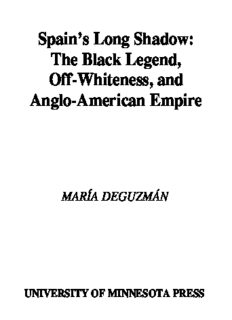
Spain’s Long Shadow: The Black Legend, Off-Whiteness, and Anglo-American Empire PDF
Preview Spain’s Long Shadow: The Black Legend, Off-Whiteness, and Anglo-American Empire
Spain’s Long Shadow: The Black Legend, Off-Whiteness, and Anglo-American Empire MARÍA DEGUZMÁN UNIVERSITY OF MINNESOTA PRESS Spain’s long shadow This page intentionally left blank spain’s long shadow ff The Black Legend, O -Whiteness, and Anglo-American Empire • Portions of chapter first appeared in “Consolidating Anglo-American Imperial Identity around the Spanish-American War (),” in Race and the Production of Modern American Nationalism,ed. Reynolds J. Scott-Childress (New York: Taylor & Francis Books, ),–. Copyright. Reproduced by permission of Routledge/Taylor & Francis Books, Inc. Portions of chapter first appeared in “Terrorism as Terrorific Mimesis in Floyd Salas’s State of Emergency(),” in Fear Itself: Enemies Real and Imagined in American Culture, ed. Nancy Lusignan Schultz (West Lafayette, IN: Purdue University Press, ),–. Reprinted with permission. Copyrightby the Regents of the University of Minnesota All rights reserved. No part of this publication may be reproduced, stored in a retrieval system, or transmitted, in any form or by any means, electronic, mechanical, photocopying, recording, or otherwise, without the prior written permission of the publisher. Published by the University of Minnesota Press Third Avenue South, Suite Minneapolis, MN - http://www.upress.umn.edu Library of Congress Cataloging-in-Publication Data DeGuzmán, María. Spain’s long shadow : the black legend, off-whiteness, and Anglo-American empire / María DeGuzmán. p. cm. Includes bibliographical references and index. ISBN---(alk. paper)—ISBN ---(pbk. : alk. paper) . American literature—Spanish influences.. United States—Civilization—Spanish influences. . Literature, Comparative—American and Spanish. . Literature, Comparative—Spanish and American.. American literature—History and criticism. . Spain—Foreign public opinion, American.. United States—Relations—Spain. . Spain—Relations—United States. . Imperialism in literature. . Spaniards in literature. . Ethnicity in literature. . Spain—In literature. . Race in literature. I. Title. PS.SD .—dc Printed in the United States of America on acid-free paper The University of Minnesota is an equal-opportunity educator and employer. For Elizabeth and Luis This page intentionally left blank contents Acknowledgments ix Introduction xi . The Shadow of the Black Legend . Imperial Visions: Moor, Gypsy, and Indian . Consolidating Anglo-American Imperial Identity around the Spanish-American War . Sacred Bulls of Modernism . (Post)Modern Denaturalizations of Nationality . Afterlives of Empire Notes Bibliography Index This page intentionally left blank ACKNOWLEDGMENTS I would like to thank Daniel Aaron, José Amor y Vázquez, Lawrence Buell, Jill Casid, Karen Encarnación, Margarita Estévez Abe, Marjorie Garber, Mary Gaylord, Roland Greene, Graham Huggan, Debbie López, Roxana Pagés-Rangel, Geoffrey Ribbans, Rennie Scott-Childress, Doris Sommer, Jack Trumpbour, and the members across the years of the Amer- ican Doctoral Colloquium (English Department, Harvard University), all of whom read or listened to initial and later portions of this manuscript and whose comments and suggestions I have tried to integrate into the present work. I would like to express my many thanks to Sacvan Bercovitch for his abiding belief in this project and to Luis Fernández-Cifuentes for his insightful readings of the chapters. I am very appreciative of the Uni- versity Research Council, the Institute for the Arts and Humanities, and especially the English Department at the University of North Carolina, Chapel Hill for granting me research and study leave as well as financial support to prepare this manuscript, among other things. In particular, for their sound advice, I would like to thank Linda Wagner-Martin and William L. Andrews. I am grateful for the archival and curatorial assistance of Jennifer Brathovde, Becky Cape, Erika Dowell, Laura A. Foster, Jennifer Hughes, Mary Ison, Ruth Janson, Claudia Jew, Francis Lapka, Danielle Mann, Daniel Moulton, Lois Oglesby, Kristin Parker, Mario Pereira, Vaughn Thibodeau, Donna VanLeer, Tessa Veazey, Nicholas Wharton, and Danielle Zahaba. I would like to acknowledge the University of Min- nesota Press, notably Doug Armato, Gretchen Asmussen, Adam Grafa, ix
Description: